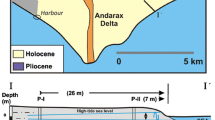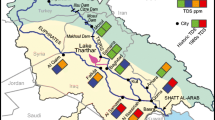Abstract
Wybong Creek discharges salts into the agriculturally and industrially important Hunter River in New South Wales, Australia. Abrupt increases in salinity occur periodically in the mid-Wybong Creek catchment. In order to understand the processes which cause these abrupt increases, changes in surface and groundwater were investigated. It is shown that salinity increases can be attributed to highly discrete groundwater discharge directly into the river from below. Hourly electrical conductivity data measured in the river showed regular, diurnal electrical conductivity fluctuations of up to 350 μS cm−1. These fluctuations could not be attributed to barometric pressure, temperature, or evapotranspiration. Instead, a similar periodicity in surface water electrical conductivity and groundwater height in nearby groundwater wells was found. Fluctuations were of similar periodicity to the orthotides which cause fluctuations in surface water height and are induced by Earth tides. The geology in the mid-catchment area indicates conditions are optimal for Earth tides to impact groundwater. The reporting of orthotidal changes in water chemistry in this article is believed to be the first of its kind in the scientific literature, with the large fluctuations noted having important implications for water monitoring and management in the catchment. Further research investigating Earth-tide-induced phases of groundwater heights will better constrain the relationships between surface water chemistry and groundwater height.













Similar content being viewed by others
References
Acworth, R. I., & Brain, T. (2008). Calculation of barometric efficiency in shallow piezometers using water levels, atmospheric and earth tide data. Hydrogeology Journal, 16, 1469–1481.
Acworth, R., Rau, G., McCallum, A., Andersen, M., & Cuthbert, M. (2015). Understanding connected surface water/groundwater systems using Fourier analysis of daily and sub-daily head fluctuations. Hydrogeology Journal, 23(1), 143–159.
Allègre, V., Brodsky, E. E., Xiue, L., Nale, S. M., Parker, B. L., & Cherry, J. A. (2016). Using earth-tide induced water pressure changes to measure in-situ permeability: a comparison with long-term pumping tests. Water Resources Research, 52(4), 3113–3126.
Australian Government Bureau of Meteorology. (2009). Climate statistics for Australian locations: monthly climate statistics, Scone (Philip Street). Canberra: Australian Government Bureau of Meteorology.
Besedina, A. N., Vinogradov, E. A., Gorbunova, E. M., Kabychenko, N. V., Svintsov, I. S., Piguleveskiy, P. I., Svistun, V. K., & Shcherbina, S. V. (2015). The response of fluid-saturated reservoirs to lunisolar tides: part 1. Background parameters of tidal components in ground displacements and groundwater level. Physics of the Solid Earth, 51(1), 70–79.
Briciu, A.-E. (2014). Wavelet analysis of lunar semidiurnal tidal influence on selected inland rivers across the globe. Scientific Reports, 4(4193), 1–12.
Burbey, T. J. (2009). Fracture characterization using Earth tide analysis. Journal of Hydrology, 380, 237–246.
Burbey, T. J., Hisz, D., Murdoch, L., & Zhang, M. (2012). Quantifying fractured crystalline-rock properties using well tests, Earth tides and barometric effects. Journal of Hydrology, 414-415, 317–328.
Cerveny, R. S., Svoma, B. M., & Vose, R. S. (2010). Lunar tidal influence on inland river streamflow across the conterminous United States. Geophysical Research Letters, 37(22). doi:10.1029/2010GL045564.
Chang, C., & Yeh, H. (2015). Uncertainty in applying the linear poroelasticity model to field situations as a result of periodic loading in heterogeneous aquifers. Hydrological Processes, 29, 2454–2462.
Cook, P. G. (1999). A guide to regional groundwater flow in fractured rock aquifers. Glen Osmond: CSIRO Land and Water.
Creelman, R. A. (1994). The geological and geochemical framework for assessing salinity in the Hunter valley. Epping: R.A. Creelman and associates.
Davis, S. N., Whittemore, D. O., & Fabryka-Martin, J. (1998). Uses of chloride/bromide ratios in studies of potable water. Ground Water, 36(2), 338–350.
Domenico, P. A., & Schwartz, F. W. (1990). Physical and chemical hydrogeology. New York: John Wiley & Sons.
Franson, M. A. H. (Ed.). (2005). Standard methods for the examination of water and wastewater. Washington: American Public Health Association, American Water Works Association, Water Environment Federation.
Gandy, C. J., Smith, J. W. N., & Jarvis, A. P. (2007). Attenuation of mining-derived pollutants in the hyporheic zone: a review. Science of the Total Environment, 373, 435–446.
Hach Company. (2009). Chemicals, reagents and standards. Loveland: Hach Company.
Jasonsmith, J. F., Macdonald, B. C. T., McPhail, D. C., Beavis, S., Norman, M., Roach, I. C., Harris, B., Isaacson, L., White, I., & Biswas, F. (2011). Salinisation processes in a sub-catchment of Wybong Creek, Hunter Valley, Australia. Australian Journal of Earth Sciences, 58(2), 177–193.
Kellett, J. K., Williams, B. G., & Ward, J. K. (1987). Hydrogeochemistry of the upper Hunter River valley, NSW. Maitland: Bureau of Mineral Resources, Geology, and Geophysics.
Kim, J.-H., Lee, J., Cheong, T.-J., Kim, R.-H., Koh, D.-C., Ryu, J.-S., & Chang, H.-W. (2005). Use of time series analysis for the identification of tidal effect on groundwater in the coastal area of Kimje, Korea. Journal of Hydrology, 300, 188–198.
Leary, S. P., & Brunton, J. S. (2003). The north west Hunter exploration programme 2003 Hunter Coalfield NSW. NSW Geological survey report no. GS 2004/238. Maitland: Department of Mineral Resources.
McMahon, T. A. (1968). Geographical interpretation of hydrologic characteristics in the Hunter Valley. Australian Geographer, 10, 404–407.
New South Wales Department of Water and Energy. (2008). Wybong Creek @ Wybong Hydroplot V132. Sydney: New South Wales Department of Water and Energy.
Rojstaczer, S., & Agnew, D. C. (1989). The influence of formation material properties on the response of water levels in wells to Earth tides and atmospheric loading. Journal of Geophysical Research, 94(B9), 12403–12411.
Rose, C. W. (2004). An introduction to the environmental physics of soil, water and watersheds. Cambridge: Cambridge University Press.
Schaetzl, R. S., & Anderson, S. (2005). Soils: genesis and geomorphology. London: Cambridge University Press.
Scheibner, E. (1998). Geology of New South Wales—synthesis. Sydney: Geological Survey of New South Wales.
Shumway, R. H. (1988). Applied statistical time series analysis. Englewood Cliffs: Prentice Hall.
Van Camp, M., & Vauterin, P. (2005). Tsoft: graphical and interactive software for the analysis of time series and Earth tides. Computers and Geosciences, 31, 631–640.
Wetzel, R. G. (2001). Limnology: lake and river ecosystems. San Diego: Academic Press.
Acknowledgements
We would like to thank Dave Hoey, Nigel Craddy, Falguni Biswas, and Pete Somerville for support during sampling trips, with many helpful discussions held with the visiting fellows of the Research School of Earth Sciences at the ANU and Brad Sherman at CSIRO. Thanks also to the wonderful farmers of the Manobalai area who so kindly let us use their land for research purposes. Project funding and support was provided by the Hunter Central Rivers Catchment Management Authority and the New South Wales Office of Water, in addition to ARC Linkage grants (number LP05060743 and LP100100567). Scholarship funding to JFJ was provided by the Australian National University Faculty of Science and the Research School of Earth Science.
Author information
Authors and Affiliations
Corresponding author
Electronic supplementary material
Table A1
Cation detection limits and concentrations in blanks. BDL indicates where solute concentrations were below detection limit. N/A indicates samples were not analysed for the ion specified (DOC 46 kb)
Table A2
Anion detection limits and concentrations in blanks. BDL indicates where solute concentrations were below detection limit. N/A indicates samples were not analysed for the ion specified (DOC 42 kb)
Fig A1
(DOC 53 kb)
Fig A2
(DOC 48 kb)
Rights and permissions
About this article
Cite this article
Jasonsmith, J.F., Macdonald, B.C.T. & White, I. Earth-tide-induced fluctuations in the salinity of an inland river, New South Wales, Australia: a short-term study. Environ Monit Assess 189, 188 (2017). https://doi.org/10.1007/s10661-017-5880-z
Received:
Accepted:
Published:
DOI: https://doi.org/10.1007/s10661-017-5880-z




